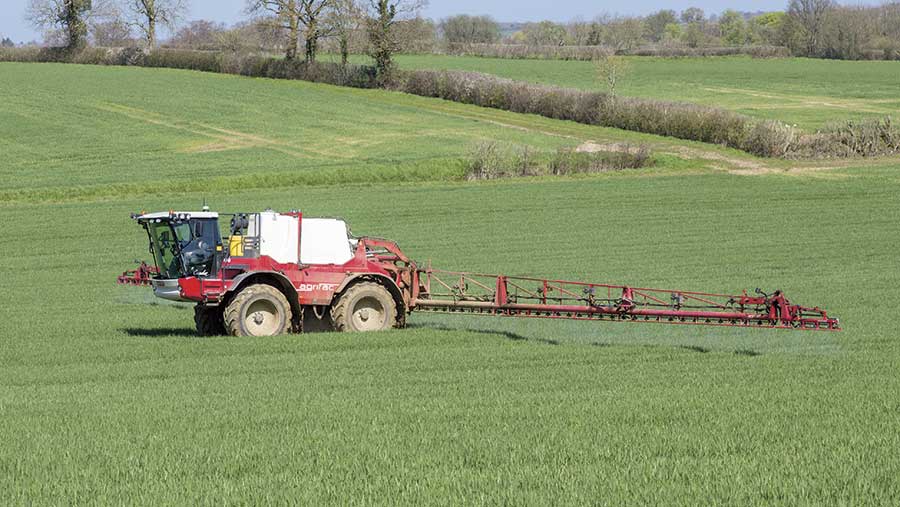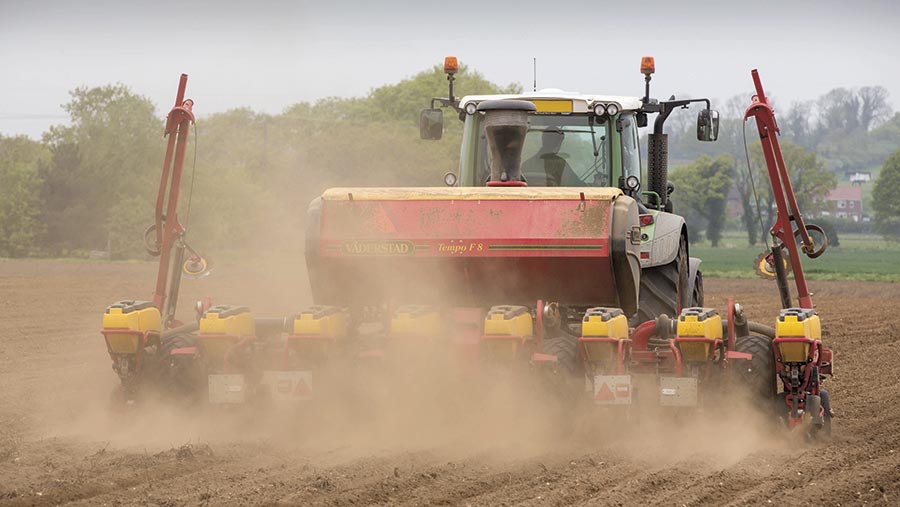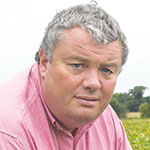Crop Watch: Battling pulse pests and a barley growth spurt
 © Gary Naylor
© Gary Naylor One key legacy of the late spring is that some cereals crops have missed out on an early growth regulator. So after the recent hot spell fuelled a growth spurt, agronomists are reviewing their plans.
There are also concerns with the growing disease and pest pressure, with wheat crops potentially facing a high septoria threat .
For pulses, some crops are being hammered by hungry pea and bean weevil, which one agronomist described as being “like a plague of locusts.”
See also: Crop Watch: Slowly catching up with fieldwork backlog

Iain Richards
South: Iain Richards
Agrii (Oxfordshire)
We are in a much better place than we were barely two weeks ago, although we’re seriously feeling the workload pressures. Most of our spring cropping ground dried out incredibly quickly once the weather relented.
So we’re going into May with only barley on the very wettest-lying land, a bit of linseed and maize still to be drilled.
Power harrow drills have been a real godsend for spring barley growers, who haven’t used them for anything other than game cover work for years.
They have allowed drilling into ground cultivated in early winter that wouldn’t have taken heavier-weight kit and also neatly avoided bringing up wet from below.
We’ve seen good results from direct drilling behind cover crops, where they were sprayed off early.
Anything cultivated after overwintered stubbles has come up wet and blocky, though. And direct drilling into uncultivated ground so hard and tight over the extended winter has required particular patience.
Rapid emergence
It is also amazing seeing barley coming through the ground in just six days. This is just as well, as the crops will need all the help they can get to deliver after their long-delayed start.
Which is why we upped their seed rates, put a good amount of nitrogen in their seed-beds wherever possible and plan to give them all their N by two leaves.
In addition to using an early plant growth regulator and Nutriphyte to encourage rooting and tillering, we’re prioritising post-emergence weed control here; mainly because seed-bed conditions and workloads meant most planned pre-emergences couldn’t go on.
Set to build up every bit as rapidly now is septoria in our wheats. This has been held back by the cold, but is ominously evident everywhere.
While waiting for the ground to dry out enough for spring drilling, we managed to get all our T0s on. This has been invaluable for growth regulation and it leaves a nice, short interval to T1s, where we’ll be countering the high septoria risk with a strong SDHI/azole/multisite mix.
Looking at oilseed rape, the shorter stands than usual by the end of April are, thankfully, giving us more leeway for our final nitrogen applications. Late stem extension spraying should do the same for our sclerotinia programme.
So far, touch wood, our crops haven’t suffered from being low down on the priority list. They’re very clean, extremely well-branched and podding up nicely. They could really use a short flowering, though.

Sean Sparling
East: Sean Sparling
AICC/SAS Agronomy (Lincolnshire)
Most oilseed rape shot into flower due to the hot conditions 10 days ago.
Light leaf spot seems under control, but that brief hot weather may get sclerotinia moving. Therefore, early-flowering protectant fungicides could be crucial. Bud abortion seems widespread due to late frosts and overall stress.
Wheats have concerning levels of septoria in the base and indeed higher up, particularly where T0 fungicides aren’t yet applied.
Leaf emergence sped up as a result of those five hot days, but now the forecast is back to cold again, the phyllochron (period between the sequential emergence of leaves on the main stem) will extend to slow L3 emergence.
Continuing wet and windy conditions mean as soon as an opportunity arises, T1s will need to be robust and ready to go. Minimum 80% azole dose, SDHI and multisites are a prerequisite. Yellow rust and mildew are also issues in the usual culprits.
Growth regulation
Winter barley growth is rapid, so ensure planned plant growth regulators are still suitable for the actual growth stage.
Spring wheat drilling has long since been abandoned, but spring barley drilling is largely completed, though much has yet to emerge and, with later drillings accompanied by a scornful cuckoo, we can only hope the old wives will be proved wrong.
Aphid activity needs monitoring in all emerging spring cereals, though levels seem only locally high.
Planted potatoes are rare and emerged fields of peas and beans equally uncommon – indeed, some are still being drilled. However, those that are through are getting hammered by hungry pea and bean weevil.
The first bean field of mine to emerge was the only one for miles and they descended upon it like a plague of locusts.

© Tim Scrivener
Of the 1,050ha of sugar beet I look after, as of 26 April, just 60% was in and of that, only 15% had emerged.
Apart from all the above, it’s all absolutely bloody wonderful.

Andy Goulding
North: Andy Goulding
CAS/Hutchinsons (Cheshire)
Wheat T1s are a priority at the moment, but evenness of emergence of the third leaf is a bit out of sync, with many crops not receiving a T0 and applications delayed on others.
It’s worth exercising a little patience to cover as many target leaves as possible for the best results.
Septoria pressure is rather enormous in some crops, especially those that were drilled early and received no T0. Products in the main are based on SDHIs, primary azoles and a multisite.
The only yellow rust to be found has been in Lili and Diego, as growers were unable to treat them before T1.
The spell of hot weather in mid-April has really motored plant growth on. I’ll be using the fast-acting plant growth regulator prohexadione, in many instances, on crops racing away.
Oilseed rape has illuminated the fields and will be receiving some supplementary foliar amine nitrogen along with their fungicides. The canopy is built, so we are now focusing on longevity to fill seeds to their potential.
Amine N is a very safe and energy-efficient way of achieving this and will provide a phased release of N over the coming six to eight weeks.
Combinable crop drilling has been a very steady affair, but should now be coming to an end.
Potato establishment
Potato plantings are also getting late, but some of the earlier plantings are now beginning to receive their residual herbicides. I’m confident with current conditions they will be applied to moist, settled ridges, with another shower to finish the job off.
Muck stores are almost empty, but the maize drills are only just getting going. Some fields have had a very hard time over the winter, with little opportunity for access without soil damage.

© Tim Scrivener
As such there is likely to be many variable crops across the county as cultivations for any depth of compaction are unlikely to be carried out. This highlights the need for soil management on continuous maize fields straight after harvest.
If the crop isn’t undersown, a light cultivation will make a huge difference to the infiltration of rainfall over winter, reducing the risk of soil erosion on these often light and overly phosphorous-enriched soils.

Stephen Harrison
West: Stephen Harrison
AICC/Southwest Agronomy (Avon)
This year continues to reinforce my belief that there is no such thing as a normal season. Record high temperatures earlier in April are being followed by the current unseasonable lows. Calendar-based agronomy is never sensible.
Leaf three is emerging or fully emerged on most wheats, although the nodal growth stage varies from 31 on later sowings to 33 on earlier-established crops.
Septoria is obvious on overwintered leaves, but has not pushed past leaf five. This is not to say that latent infection is not present in younger leaves.
Leaf three sprays are being based on strongly eradicant SDHIs with chlorothalonil and an azole on varieties rated 6 or less for resistance. Yellow rust has been conspicuous by its absence this year.
Wheat diseases
We do not expect disease control to be compromised by the absence of a T0 this season. No earlier spray does mean the first split of chlormequat has been missed.
Growth regulation has been stepped up with the leaf three spray and an ethepon-based product may well be required at flag leaf timing. Soil temperatures are up about 11C and adequate soil moisture means growth will be rapid when air temperatures rise.
The earliest winter barleys have awns emerging. It seems like sprayers that have only recently completed early stem extension applications will be straight back into the fields.
In a catchy season such as this, do all you can to ensure maximum efficiency. Check spray deliveries as they arrive and sort materials to save time once spraying opportunities arise.
High on the technical agenda is planning for barley yellow dwarf virus (BYDV) control this autumn now that neonicotinoid seed treatments are banned.
Plenty has already been said about the green keyboard warriors defeating sound science. Our task is now to ensure clients are best advised to use the tools still available to limit BYDV damage.

